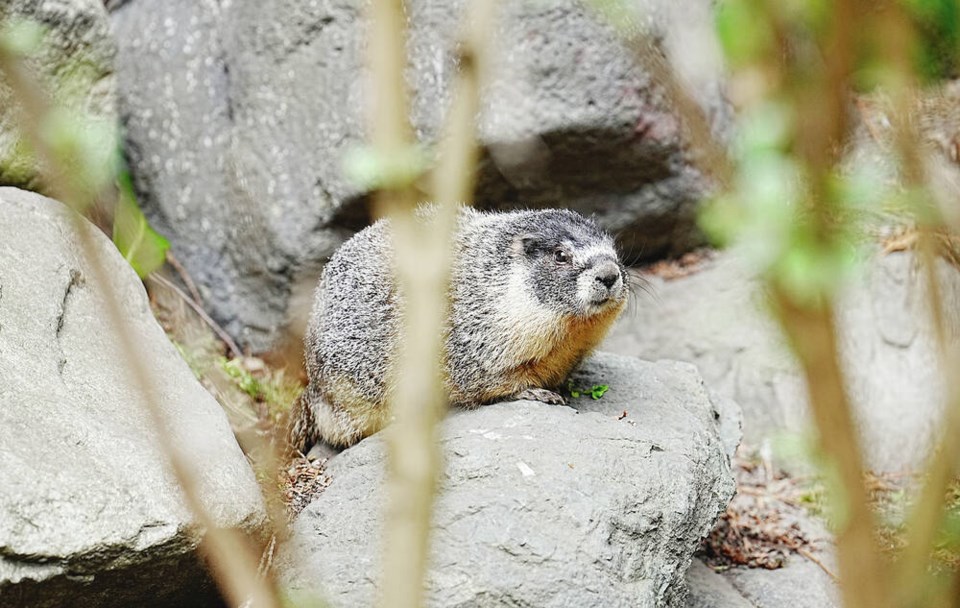Warm day, cherry blossoms blooming, we’re basking in the sun in front of The Empress when Roger elbows me in the ribs.
“There’s Ed Bain,” he says, nodding toward the sidewalk.
“You want to meet him?” I ask. “He came from Alberta, just like you.”
Roger quickly shakes his head, no. Marmots are shy that way.
He keeps tracking Ed with his eyes, though: “He looks younger than I expected.”
“Pot, meet kettle,” I reply.
Well, he couldn’t dispute that. For an animal that many didn’t think would emerge from hibernation this spring, Roger looks pretty youthful.
That is, no one is quite sure how old he is but it has to be up there, seeing as he’s been living in a rock grotto outside the hotel since 2008. That’s 15 years, which matches the life expectancy of the average marmot. Who knows how long he was alive before that?
Conventional wisdom says Roger probably came from Wild Rose Country, hitching a ride on a transport truck when the dot.com bubble burst and the oil patch dried up.
Victorians were leery of him at first. He wasn’t like our own, native Vancouver Island marmots, the ones who live in a hippie colony on Mount Washington, snowboarding, playing hackey sack and lounging on the slopes smoking weed, which makes them vulnerable to predation and therefore frightfully endangered.
No, Roger was a yellow-bellied marmot, which sounds like something Yosemite Sam would call Bugs Bunny, but is in fact another species of rodent altogether. As was the case with Calgary Flames fans and pipeline supporters, there were gazillions of yellow-bellied marmots in Alberta but none in downtown Victoria when he landed here in ’08.
Back then, his appearance caused consternation. Some blamed him for driving up house prices and wanted to slap him with a two-per-cent speculation tax. Others, worried that yellow-bellies would breed and proliferate, called for him to be trapped and deported. Indeed, there were at least four failed attempts to capture Roger before someone thought to ask how, with no other marmots to mate with in the city, he was supposed to breed and proliferate. Like, who would he hook up with, Marty the Royals mascot?
After that, we warmed to Roger (who is named after Roger Soane, a former Empress manager). Today, like Ed, Roger is a familiar local fixture, fondly regarded, albeit with less-discerning eating habits. Tourists and locals alike snap his picture from the edge of his grotto, where the hotel has posted a sign telling his story.
Why our change in attitude? Maybe it’s because we began to focus not on what set Roger apart from the rest of us, but what we had in common. We saw in the plucky little fellow the wanderlust that caused so many of us (or our forebears) to break free of the velvet shackles of a comfortable existence and strike out for an exciting, albeit occasionally lonely, new life in a strange land.
It’s why we cheered on so many of Roger’s animal pals when they, too, bolted for freedom. In 2014, Lucy the 150-pound emu became a folk hero after breaking away from a Nanaimo-area farm, his capture (yes, Lucy was a boy) documented by a television news camera on a hovering helicopter. In 2017, a heifer dubbed Metchosin Moodini came back pregnant (!) several months after soaring over a Happy Valley Road farmyard fence. And it broke our hearts in 2020 when we lost Takaya, the wolf who led a solitary existence on Discovery Island off Oak Bay.
Like Takaya, Roger is something of a lone wolf. An aging one, too. Maybe that’s why so many Victorians see themselves in him. Demographically, the capital has a high proportion of single seniors.
Statistical clues can be found in the 2021 census. A quarter of Victoria residents are over age 65. Of the 88,000 people in the city proper, 24,000 live by themselves. The 45,000 people over age 15 who are neither married nor living common-law include 15,600 — two-thirds of them women — who are either widowed, divorced or separated. Not all of the latter are seniors, of course, but many are. In any case, Roger is far from alone in being alone in Victoria.
You never know, though. Note that another yellow-belly turned up in Saanich last May. It was handed over to Metchosin’s Wild ARC, then banished to the mainland, just like several former premiers. Conservationists squirm at the idea that a breeding pair (of marmots, not politicians) will make its way here.
That’s often how we react to outsiders, until we get to know them, until we get to see what we share.
>>> To comment on this article, write a letter to the editor: [email protected]



